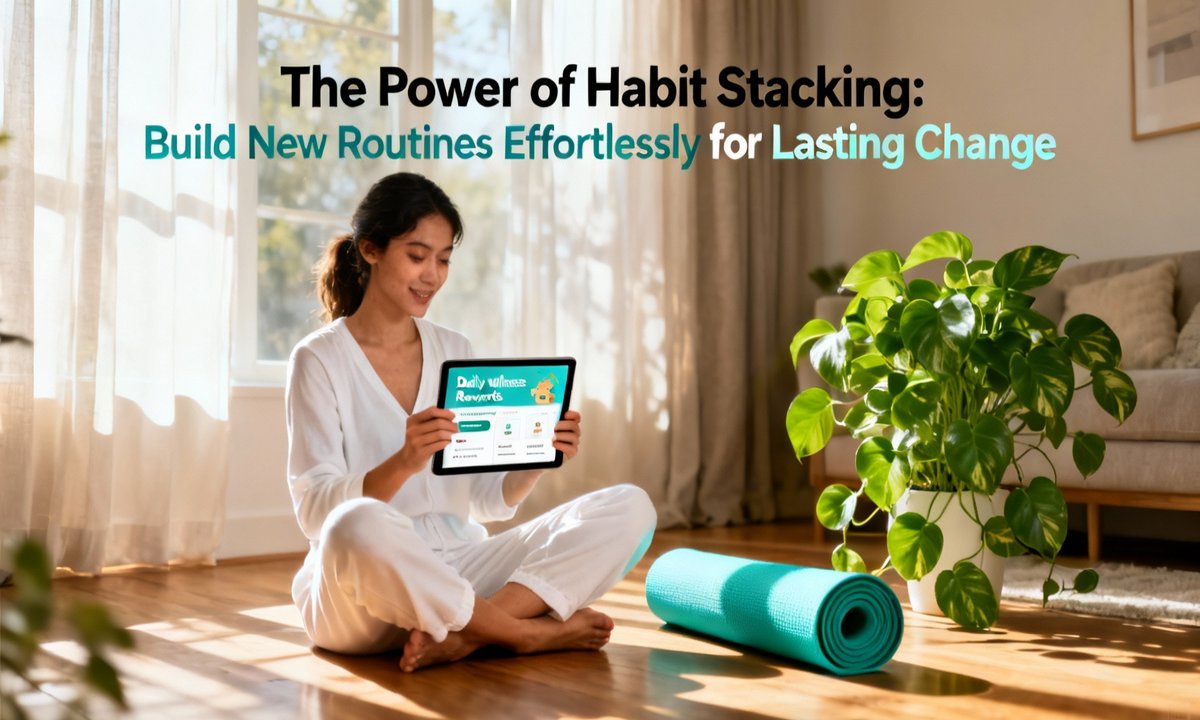Many of us aspire to healthier eating, saving money, or becoming more active. Yet, keeping these new goals can be challenging when daily life gets busy. There is a method proven to help small changes endure, making new routines feel less like an uphill battle and more like a natural part of your day.
Unlocking Effortless Change with Habit Stacking
Habit stacking involves linking a new desired habit with one you already perform automatically. Instead of creating a new routine from scratch, you integrate the new behavior into an existing one, such as brushing your teeth or making coffee. This approach leverages your brain’s natural inclination for routines, making new actions feel less forced and more consistent.
By building upon established routines, you can reduce decision fatigue and friction, creating a smoother path toward positive change. This method helps your brain bypass constant deliberation, making the adoption of new habits much more manageable and effective. The underlying science has been recognized for decades, supporting its effectiveness. (NPR)
The Psychology Behind Sticking to New Habits
Our minds are wired for efficiency, which explains why your morning coffee ritual or evening wind-down feels automatic. Linking a new action to an existing one capitalizes on this natural tendency. You won’t need constant motivation because the established habit acts as a natural trigger for the new behavior, offering powerful cues and rewards that reinforce the change.
Consider wanting to start meditating but frequently forgetting or running out of time. By committing to meditate for two minutes immediately after brushing your teeth, meditation becomes as integral to your morning as using toothpaste. This simple connection helps embed the new practice seamlessly into your day.
Mastering Habit Stacking: A Step-by-Step Guide
To begin, identify an anchor habit—a routine you perform without conscious thought, like getting dressed or loading the dishwasher. Next, choose a new habit you wish to incorporate. It should be small enough to be easily actionable, such as drinking one glass of water or performing three stretches.
Formulate a clear “When/Then” statement to solidify the connection, for example: “When I finish my morning tea, then I will read one page of a book.” Consistency is crucial. Each small achievement boosts dopamine levels, creating momentum and reinforcing the new behavior over time.
Real-Life Applications for Everyday Improvements
You can easily integrate new habits into your day. After reviewing your daily schedule, consider adding a two-minute stretching session. Once dinner is finished, you might immediately follow up with a kitchen clean-up routine to maintain an organized space. Explore tips for fast, organized meal prep to make this even smoother. (meal prep tips)
When you conclude your workday and turn off your laptop, take a moment to review tomorrow’s priorities or jot down a brief reflection. Habit stacking is not about transforming your life overnight but about gently weaving new, positive actions into your existing daily patterns and gradually expanding them.
Building Layers of Positive Change
Once a single stacked habit feels automatic, you can begin to chain together more small steps. For instance, after putting on your shoes, you might go for a 10-minute walk, then follow by filling a water bottle. This creates a positive cascade, making routine adjustments less demanding and more natural.
The Science of Small Wins for Lasting Habits
Research indicates that minor behavioral adjustments are more likely to yield lasting results than drastic overhauls. The brain positively responds to actions that feel easy and rewarding. For many, willpower is finite, and habit stacking reduces the need for constant self-control, paving the way for sustained positive change. (Harvard Health)
Incremental successes build self-efficacy—the belief in your ability to succeed—which can then propel larger routines. Over time, these stacked habits can lead to significant improvements, from reduced stress and increased productivity to a healthier lifestyle overall.
Expanding Habit Stacking for a Sustainable Future
Habit stacking extends beyond personal goals, becoming a powerful tool for sustainability and financial management. Imagine linking turning off lights to leaving a room, or checking your thermostat before bedtime. These minor adjustments can significantly accumulate. Discover more smart energy-saving habits and stylish decor ideas that boost energy efficiency and comfort. (energy-saving habits, eco-chic home decor)
Transforming Your Home and Finances
For groceries, after planning dinner, consider prepping one lunch for the next day to save time and money. Explore budget-friendly meal prep strategies. When decluttering, after unloading groceries, aim to toss one expired pantry item. Learn smart storage tips for every room. (meal prep strategies, smart storage tips)
Regarding energy savings, after loading the dishwasher, make it a habit to turn off the kitchen lights. You can find more insights on smart home upgrades for maximum savings. These simple chains can revolutionize how you manage your home and finances, fostering a more efficient household. (smart home upgrades)
Maximizing Your Habit Stacking Success
Start Small and Build Confidence
Begin with one simple pair—a single action that’s quick and easy. Initially, stack only once per day. As it becomes ingrained, gradually increase complexity or frequency. Patience is key; new routines can take varying amounts of time to solidify, depending on the behavior and individual circumstances. (European Journal of Social Psychology)
Use Cues and Rewards
Make your habit stack enjoyable! Strategically place reminders or cues where you are most likely to see them. Celebrate each completion, whether with a simple checkmark, a compliment to yourself, or a small treat. These positive reinforcements help solidify the new behavior.
Troubleshoot with Flexibility
If you miss a day or encounter disruptions, do not abandon your efforts. Evaluate whether your anchor habit is robust enough, or if the new habit needs adjustment. Habit stacking is about adapting to real life, rather than striving for unattainable perfection.
Innovative Ideas for Your Habit Stacks
Consider adding a minute of mindful breathing before meals to enhance your well-being. Review your spending habits immediately after paying a bill, which can lead to greater financial freedom. You could also water your plants right after making your morning coffee, fostering a greener indoor environment. (financial freedom, indoor plants)
Each habit you stack reflects your personal values, whether they involve wellness, financial prudence, mindfulness, or diligent home care. By consciously choosing and integrating these small actions, you align your daily routines with your broader aspirations.
Common Challenges and Solutions for Sticking to Stacks
If a habit stack doesn’t stick, it might be too ambitious or complex. Try breaking it down into even smaller, more manageable steps. An anchor habit might not be automatic enough; choose something you genuinely never skip, like brushing your teeth, for a stronger foundation.
A lack of reward can also hinder progress. Find small ways to celebrate every win, no matter how tiny, to keep motivation high. If forgetting is an issue, place written reminders near your anchor habit or set a phone alert until the new behavior becomes automatic.
Inspiring Success Stories
Many have found success with habit stacking. One individual wanted a tidier kitchen, so after her morning coffee, she now consistently wipes down the counters. Another paired reviewing his grocery list with putting on his shoes, ensuring he never shops without a plan. Others make eco-friendly choices by always grabbing reusable bags after their keys.
Ready to Begin Your Habit Stacking Journey?
Select one existing automatic habit. Then, choose a small action you consistently wish to perform more often. Write down your “When/Then” statement, keep it visible, and observe the positive shifts after a week. You might even connect your initial stack to a larger personal transformation, such as a home makeover. (home makeover ideas)
Further Resources for Habit Building and Home Improvement
For streamlining your living space, explore essential gadgets that simplify your life. Discover creative upcycling ideas to transform household items into unique home decor, adding both style and sustainability to your environment. (essential gadgets, upcycling ideas)
Boost your home’s air quality by learning about the top indoor plants for a healthier living space. Additionally, uncover unexpected ways to enhance home energy efficiency beyond just adjusting thermostats, contributing to both comfort and savings. (indoor plants, energy efficiency)
What habit stacks will you implement this week? Begin with small steps and acknowledge your accomplishments. Feel free to share your experiences or explore more resources on mindful living and smart routines.
References:
NPR: The Brain Science Behind Habits
Harvard Health: Making Habits Stick
European Journal of Social Psychology



